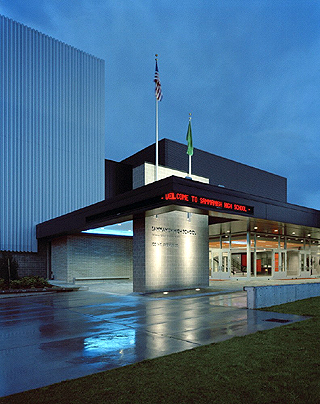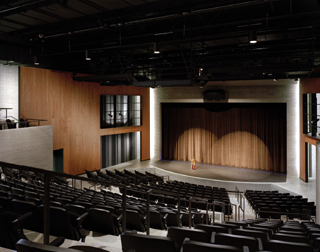|
Subscribe / Renew |
|
|
Contact Us |
|
| ► Subscribe to our Free Weekly Newsletter | |
| home | Welcome, sign in or click here to subscribe. | login |
Construction
| |
 |
September 20, 2007
Performing arts spaces gain sophistication
Mahlum Architects

Reifert
|
School districts in the Puget Sound are providing increasingly sophisticated and flexible venues for their performing arts programs despite rising construction costs and increased competition for budget dollars.
Accommodation for the arts reflects widespread support of arts education, as evidenced by a recent Harris Poll that indicates 93 percent of Americans believe arts are vital to providing a well-rounded education for children.
Sometimes considered an educational stepchild outside the core curriculum of English, mathematics, social studies and science, the arts have proven their mettle in positive spillover effects to other studies. Independent studies have repeatedly shown that students enrolled in arts education have higher math and verbal SAT scores than students who take no arts classes.

Still, districts must grapple with financing issues, appropriate design and sizing of the facility, and community sensitivities. There is no one design that’s right for performing arts spaces, and virtually every venue built or renovated in the past decade in this region has been unique to the district and site. Nevertheless, all new performing spaces are better equipped than they have been in the past, with improved acoustics, lighting and fly-loft space.
Venues, new and restored
The 1927-era Cleveland High School, for example, has one of the last remaining historic auditoriums in the Seattle School District. When the current renovation of the school is completed by the end of this summer, the theater will have been restored to its original appearance but with reshaped sides, improved acoustics, new lighting and new seating. The venue was designed specifically to accommodate the school’s well-established drama program as well as local theater groups.
By contrast, Nathan Hale High School in the North Seattle is noted for a strong debate and music program. When the district decided to build the school’s first-ever performing auditorium, the design provided for more of a music hall venue with separate spaces for forums and debate gatherings.
The stage is large enough to hold an entire orchestra and the pit is sized to accommodate only small ensembles. The seating area appears as a floating box that envelops the stage and hovers above a ground-level gallery for student artwork.

The forums are an unusual feature of the design, and they reflect the school’s commitment to performance-based assessment. This approach, in which students stand and present information, dictated the creation of spaces for such presentations and group learning, both indoors and out.
Edmonds-Woodway also has a strong music program, and its commons has been designed as a great hall equipped with theatrical lighting and sound-enhancing roof and acoustical draperies. Like virtually all schools, the hall is used by community groups and has even been as a venue for weddings.
Drama is a major focus at Sammamish High School, where a $17.3 million expansion and modernization program completed in 2004 gave the arts magnet school a new 450-seat performing theater, entrance lobby and administration wing.
A 70-foot-tall fly loft necessitated a large building, which became the new visual identity for the school. A marquee reader board wraps the entire entry canopy.
In addition to the theater, the building includes a scene shop, costume shop, dressing rooms, green room and storage for props.
Flexibility a must
Even though the focus of the arts program may vary from school to school, virtually all require flexibility for use by a variety of groups, both from within the school and the community.
The proposed new Issaquah High School will feature a 600-seat performing arts center as well as a 100-seat black-box theater. It will be open onto a commons that will become, in effect, an expanded lobby. The theater will likely be used by for community meetings as well as by local theater groups.
Looking ahead, we will probably see more sharing of community resources as schools expand and modernize. Such sharing can offset construction and operating costs, and it only makes sense to develop partnerships that benefit not only the school but the community.
In Medford, Ore., the school district is planning two different kinds of performing arts spaces that can support performances, dance ensembles, town meetings and other public gatherings.
One high school has a 700-seat theater with full fly loft and accessibility upgrades that could be used for large musicals. The other school will have a 400-seat black-box studio theater suitable for plays. Students will be able to use the space at each other’s school.
The Tacoma School of the Arts, which has three locations in downtown Tacoma, is likewise committed to sharing with the community.
Students use the local museums and theater spaces as resources and learning areas. The University of Washington Tacoma provides some teaching spaces in exchange for use of the school’s art studios.
Taxpayers support construction of performing arts venues, but it will be incumbent on school districts to continue to seek maximum flexibility of space use and creative ways to share resources to keep overall costs within budget.
Gerald “Butch” Reifert is a principal with Mahlum Architects, with offices in Seattle and Portland.
Other Stories:
- Cascadia college building will be green inside and out
- Owners, designers can harness the Web too
- ‘I wish I could go to a school just like this’
- Light ‘chimneys’ cool off Tacoma school
- Lynnwood a proving ground for green schools
- Spokane takes a chance on GC/CM
- Seattle gets creative to expand bidding pool
- Public school projects fall out of favor with bidders
- Case for operable windows isn’t open and shut
- Tomorrow’s schools will be greener, freer


